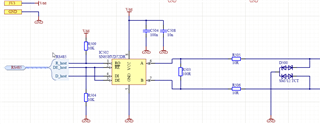Dear all, we have got a design with SN65HVD72 and extra external world protection (similar to what is suggested in UG with 10R series resistors). Unfortunately, due to miswiring the device, in some cases the bus signals (A or B or both) were connected to 24V for several seconds.
Inspecting such devices the input TVS (CDSOT..) was damaged and the series resistors (10R) burned (0603, general purpose rating). Later bench top testing revealed that it looks like the transceiver itself works, however we are not sure about its health as the trasceiver must have experienced excursions beyond absolute maximum ratings.
Due to the silicon starvation issues, we would like to repair such devices, for which I'd like to ask you - in such situation, is it possible, that the transceiver would have sent something nasty to the supply line and/or to the data/enable signals? We are happy to replace the transceiver as a suspect part, however the 3V3 supplies number of other components and data signals are connected to an onboard MCU (DE/RE directly, TX has got series 100R and RX over series 1k).
The devices _seem_ working well (after replacing the TVS and passives), however we are concerned about latent damages that may shorten the device lifetime unpredictably.


